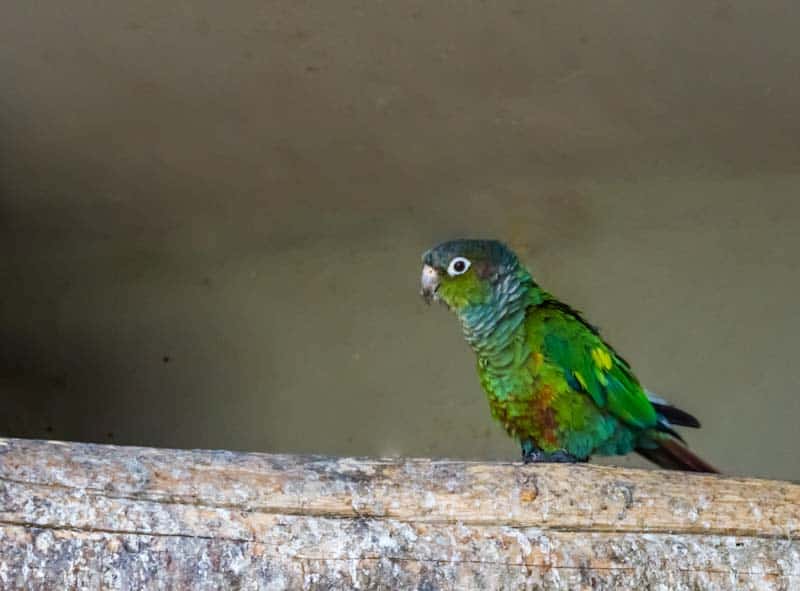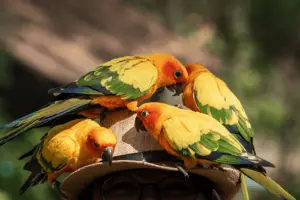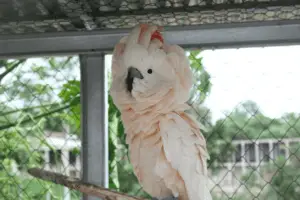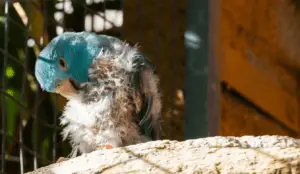You should get a Green Cheek Conure if you love beautiful birds with silly antics that can keep you laughing. This small-sized parrot belongs to the genus Pyrrhura and is native to the woodlands of Brazil, Argentina, and Paraguay. The fact that it’s known for its comical antics and beauty makes it an excellent pet for beginners.
The Green-Cheek Conure is available in multiple color variants thanks to color mutations. You can get a yellow-sides, Cinnamon, and Pineapple color variation to help beautify your home. But despite their different colors, these birds have the same personality.
Besides beautifying your home, the Green Cheek Conure is a great pet that can improve the quality of your life. It can leave you smiling and help you forget about your busy day at work. So to help you pick the correct type of Green Cheek Conure for your home, we have compiled the following article. We’ll show you the different types of Green Cheek Conures available.
What is a Green-Cheeked Conure?
The Green Cheek conures are comical and outgoing but can be shyer than most. They love playing, especially with some rotating toys. Therefore, they need a spacious cage to play and run around. It is quite popular, especially among parrot novices. And that’s because they’re small-sized, affordable, and have lower noise levels.
This parrot is the smallest conure species, usually confused with Maroon-bellied Conure. And that’s because they resemble each other; even pet stores mistake one for the other. They’re the same size and green in color, but the Green-Cheeked is a tad brighter.
Unfortunately, they’re prone to biting, especially when young, but you can eliminate this bad behavior with a little time and patience. Plus, when cared for, they can live for up to three decades to be a lifetime companion. But which type of Green-Cheeked Conures is ideal for me?
Type of Green Cheek Conures
If you’re familiar with parrots and have even interacted with some, you must have heard or seen a Green Cheeked Conure. But do you know that there are different types of Green Cheek Conures? Well, there are over 6 Green Cheek Conures that make exceptional pets. But despite the difference, they’re funny creatures with different personalities.
Therefore, you can get a Green-Cheeked Conure that matches your personality. So let’s look at the most common types of Green Cheek Conures.
- Normal Green Cheek Conure
The wild-type conure, considered the normal type of green cheek conure, is richly green with a maroon tail. It also has darker feet, beaks, and heads. Outside the usual breeding season, this bird survives in a flock of over ten birds. They are known for nesting in hollow trees, where they start laying eggs in February.
Like most birds, the normal Green Cheek Conure is a monogamous creature, and both parents can help raise their young ones. (2) The normal Green Cheek Conures are the most affordable, but that does not mean they are less attractive. They love clowns that love cuddling in their owner’s pockets or sleeves.
- Cinnamon Green Cheek Conures
This mutation features pale colorations on their feathers and lime green plumage. Compared to the usual Green-Cheeked Parakeets, this color mutation has lighter maroon tail feathers. On top of that, this species does come with a tan head. This bird’s eyes are generally ruby red and fade with time, thanks to overexposure to UltraViolet light.
This mutation results in some beautiful birds; the sex-linked mutations give them a distinct look. If you’re lucky, you can find this bird at the local shelter, but you are likely to get one from the breeder.
Like most parrots, it does have an independent personality and can be shy in front of strangers. They’re cautious and can take a few hours or days for it to warm up to you. But they are very affectionate creatures. They may prefer staying in their cages inside their cages instead of playing outside the cage.
- Turquoise Green Cheek Conures
Named correctly, the Turquoise bird is a perfect mix of dark blue with green. It’s considered the largest and the rarest Green Cheek Mutation coloration. Like the pearly cockatiels, this mutation is bigger than the other recessive colors.
The turquoise-green cheek conures have mostly bluish-green plumages with some grayish tail feathers. The bird’s head and beak are glowing blue-dull. This bird gets its name from its turquoise green cheeks and is considered the most independent.
Turquoise Conure is standoffish behavior, but it can give you lots of snuggles. They’re autonomous of the six and most aloof but can be quite affectionate.
- Yellow-Sided Green Cheek Conure
The yellow-sided is one of the rarest color mutations of all the green cheek conures. You can get only one in about ten clutches, which has played a significant role in its ever-increasing value. The yellow-Sided Conure looks like the Normal wild type from behind; after all, it does have a dark green back.
The color of this bird’s tail varies between light red and maroon. On top of that, it has bright-colored breasts that can easily graduate from reddish feathers to dark gray and yellow heads. (1) They also have dark eyes, beaks, and feet. Their hatchlings are normally covered by some white fluffy down.
The Yellow-sided bird loves clowning just like it does napping or snuggling with its owner. It’s a fun-loving and gentle bird that’s fun to have around. Plus, you’ll never have a dull day with the yellow-sided Green Cheek Conure in your home.
- Pineapple Green Cheek Conures
This variation is a perfect combination of the Yellow-sided and Cinnamon variations. After all, it does have yellow sides like the yellow-sided and light-colored head-like cinnamon variation. But what helps it stand out is its brightly-colored chest. Like the Cinnamon variation, it does come with lime greenish back feathers.
Its eyes are ruby red, while its tail feathers are pale. Since it’s a crossbreed of the Yellow-sided and Cinnamon Green-Cheeked Conures, it does have a fun-loving demeanor and is always ready to play with its owner. It will initially be shy when introduced in your home, but that will change with time. Therefore, you should expect it to warm up to most strangers visiting your home, making it a great parrot.
- American Dilute Green Cheek Conures
The American Dilute conure has a cream or light beige plumages like most parrots. The American dilute resembles the Cinnamon variation, except it has dark feet and a dark bluish beak. Some unique whitish fluff usually covers their hatchlings.
Like all the other variants, these Green Cheek Conures are friendly and fun-loving creatures that love playing with their toys. And the fact that it’s affectionate and gentle makes it an exceptional option for first-time parrot owners.
- Dilute Green Cheek Conure
Generally, the amount of red spread all over its body can vary, but you will notice a pigment on its feet. It’s the outcome of the recessive mutation that reduces melanin, a process known as Dilute. Other popular dilute variants include:
- Dilute Yellow-Sided Conure: The sex-linked mutation these beautiful Green-Cheeked conure birds undergo plays a significant role in increasing their bodies’ red and yellow pigmentation.
- Dilute Cinnamon Conures: this light cream bird has a white beak and feet. It also has cream-to-whitish breasts and a head with red on its chest.
- Ghost or Muted Green Cheek Conures
Another popular Green Cheek Conure variant is the Muted Conure. The muted or ghost conures feature muted-mint plumages with light blue wings, stomach, tail, chest, and head. Bird lovers prefer this mutation because of its muted mint feathering colors. They also love it for its affectionate personality; the fact that it can easily get attached to its owner is a bonus.
Unfortunately, when bored or stressed, this bird can turn to self-mutilation; it can pluck its feathers when stressed. Luckily, you can easily cure this problem by giving it more toys to keep it busy.
Other Types of Green Cheek Conures
- Turquoise Yellow-Sided: it is a combination of opaline mutation and turquoise mutation.
- Turquoise Cinnamon: a combination of Cinnamon and turquoise mutations.
- Turquoise Pineapple Conure: it’s a perfect combination of opaline and turquoise mutations.
- Mint Green-Cheeked Conures: the mint conure is a crossbreed of turquoise and dilute mutation.
- Mooncheek Green-Cheeked Conure: this variant combines Cinnamon, Opaline, and Turquoise mutations.
Conclusion
The Green-Cheeked Conure is an exceptionally comical creature that can improve your moods after a busy day at work. Their unique personality is one of the key reasons why they’re popular with first-time parrot owners. Luckily there are over seven types of Green-Cheeked Conures that vary in color and personality for you to choose from.
You should go for the Normal Green-Cheeked Conures if you’re working with a tight budget. On the other hand, the Yellow-sided Green Cheek Conure can go for up to $800. Therefore, with proper research, you can find a perfect companion matching your personality.
- Wikipedia contributor, Green-Cheeked Parakeet, https://en.wikipedia.org/wiki/Green-cheeked_parakeet/ Accessed May 15, 2023
- Green Cheek Conure, https://www2.newpaltz.edu/~mcglinnl/animals/greencheekedconure.htm/ Accessed May 15, 2023
- YouTube contributor, Top Green Conure Parrot Varieties/ Green Cheek Conure Mutation/ Type of Green Cheek Conure, https://www.youtube.com/watch?v=4XqMwDYY2fo/ Accessed May 15, 2023










